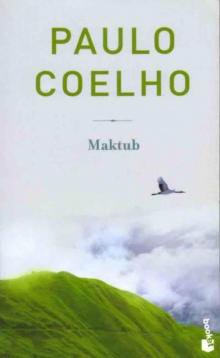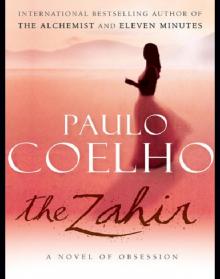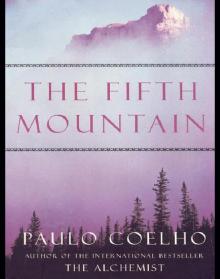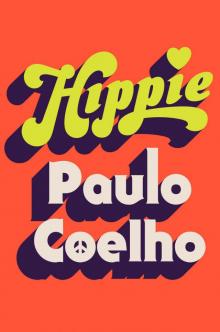- Home
- Paulo Coelho
The Winner Stands Alone Page 15
The Winner Stands Alone Read online
Page 15
The palace, however, was the same, although another much larger one was being built not far from there. Hamid arrived at the meeting in an excellent mood, saying that he had just received an excellent job offer and no longer needed the sheikh's financial help; indeed, he would pay back every penny invested in him.
"Hand in your resignation," said the sheikh.
Hamid didn't understand. He knew that the business his father had left him was doing well, but he had other dreams for his future. However, he couldn't defy this man who had done so much to help him--not a second time.
"At our first meeting, I was able to say no to Your Highness because I was defending my father's rights, which were always paramount. Now, though, I must bow to your will. If you think you have lost money by investing in my work, I will do whatever you ask. I will come home and look after my inheritance. If I have to give up my dream in order to honor the code of my tribe, I will do so."
He spoke these words without a tremor. He dared not show any weakness before a man who so respected other men's strength.
"I'm not asking you to come home. The fact that you were promoted is a sign that you're ready to set up your own company. That is what I want you to do."
"To set up my own company?" thought Hamid. "Did I hear him right?"
"More and more of the big fashion companies are setting up business here," the sheikh went on. "And they're no fools. Our women are beginning to change the way they think and dress. Fashion has had an even bigger impact on our region than foreign investment. I've spoken to men and women who know about these things. I'm just an old Bedouin who, when he saw his first car, thought it would have to be fed like a camel.
"I'd like foreigners to read our poets, listen to our music, to sing and dance to the songs that were passed down from generation to generation by our ancestors, but no one, it seems, is interested in that. There is only one way in which they can learn to respect our tradition, and that is via the world in which you work. If they can understand who we are by the way we dress, they will eventually understand everything else."
The following day, Hamid met a group of investors from various other countries. They placed at his disposal an enormous sum of money and gave him a deadline by which it had to be repaid. They asked him if he was ready and prepared to accept the challenge.
Hamid asked for time to think. He went to his father's grave and prayed all afternoon and evening. That night, he walked in the desert, felt the wind freezing his bones, then returned to the hotel where the foreign investors were staying. "Blessed be that which gives your children wings and roots," says an Arabic proverb.
He needed his roots. There is a place in the world where we are born, where we learn our mother tongue and discover how our ancestors overcame the problems they had to face. There always comes a point when we feel responsible for that place.
He needed wings too. They reveal to us the endless horizons of the imagination, they carry us to our dreams and to distant places. It is our wings that allow us to know the roots of our fellow men and to learn from them.
He asked for inspiration from God and began to pray. Two hours later, he remembered a conversation he had overheard between his father and a friend in his father's shop:
"This morning, my son asked me for money to buy a sheep. Should I help him, do you think?"
"Since it clearly isn't a matter of urgency, wait another week before giving him your answer."
"But I have the means to help him now. What difference will a week make?"
"A very great difference indeed. Experience has taught me that people only give value to a thing if they have, at some point, been uncertain as to whether or not they'll get it."
Hamid made the investors wait a week and then accepted the challenge. He needed people who would take care of the money and invest it as he wanted. He needed staff, preferably people who came from his own village. He needed another year in the job he was doing, so that he could learn what he still needed to know. That was all.
"EVERYTHING STARTS WITH A MEETING of the main suppliers of dyes."
Well, that isn't exactly true: everything begins when the companies involved in studying market trends (cabinets de tendence in French, "trend adapters" in English) take note of the different things--among them fashion--in which each layer of society is currently interested. This research is based on interviews with consumers, the close monitoring of samples, but, above all, on careful observation of a particular cohort of people--usually aged between twenty and thirty--who go to nightclubs, hang out on the streets, and read the blogs on the Internet. They never look at what's in the shop windows, even at name brands, because everything there has already reached the general public and is therefore condemned to die.
The trend adapters want to know what will be the next thing to capture the consumers' imagination? Young people don't have enough money to buy luxury goods and so have to invent new ways of dressing. Since they live glued to their computer screens, they share their interests with like-minded others, and these interests can often become a kind of virus that infects the whole community. Young people influence their parents' views of politics, literature, and music, and not, as ingenuous adults believe, the other way round. However, parents influence young people's "system of values." Adolescents may be rebellious by nature, but they always believe the family is right; they may dress strangely and enjoy listening to singers who howl and break guitars, but that's as far as it goes. They don't have the courage to go any further and provoke a real revolution in behavior.
"They did that in the past, but, fortunately, that particular wave has passed and returned to the sea."
All these studies of market trends show that society is now heading toward a more conservative style, far from the dangers posed by suffragettes (the women at the beginning of the twentieth century who fought for and achieved the right to vote) or by hairy, unhygienic hippies (a group of crazies who believed that peace and free love were real possibilities).
IN 1960, FOR EXAMPLE, THE world was caught up in the bloody wars of the post-colonial era, terrified by the threat of nuclear war, and although we were also living through a period of economic prosperity, we were all desperately in need of a little joy. Just as Christian Dior had understood that the hope of future abundance could be expressed through clothes using yards of material, the designers of the sixties went in search of a combination of colors that would lift people's morale and came to the conclusion that red and violet were simultaneously calming and stimulating.
Forty years later, the collective view had changed completely: the world was no longer under the threat of war, but of grave environmental problems. Designers were opting for colors drawn from the natural world: the sands of the desert, the jungles, the sea. Between these two periods, various other trends--psychedelic, futuristic, aristocratic, nostalgic--arose and vanished.
Before the great designer collections are fully defined, these studies of market trends are used to give a snapshot of the world's current state of mind. It seems now that--despite wars, famine in Africa, terrorism, the violation of human rights, and the arrogant attitude of certain developed countries--our main preoccupation is saving poor planet Earth from the many threats created by human society.
"Ecology. Save the planet. How ridiculous."
Hamid knows, however, that there's no point in fighting the collective unconscious. The colors, the accessories, the fabrics, the so-called charity events attended by the Superclass, the books being published, the music being played on the radio, the documentaries made by ex-politicians, the new films, the material used to make shoes, the new bio-fuels, the petitions handed in to members of parliament and congressmen, the bonds being sold by the largest of the world banks, everything appears to focus on one thing: saving the planet. Fortunes are made overnight; large multinationals are given space in the press because of some completely irrelevant action they are taking; unscrupulous NGOs place advertisements on the major TV channels and receive hundreds
of millions of dollars in donations because everyone seems obsessed with the fate of the Earth.
Whenever he reads articles in newspapers or magazines written by politicians using global warming or the destruction of the environment as a platform for their electoral campaigns, he thinks:
"How can we be so arrogant? The planet is, was, and always will be stronger than us. We can't destroy it; if we overstep the mark, the planet will simply erase us from its surface and carry on existing. Why don't they start talking about not letting the planet destroy us?
"Because 'saving the planet' gives a sense of power, action, and nobility. Whereas 'not letting the planet destroy us' might lead to feelings of despair and impotence, and to a realization of just how very limited our capabilities are."
However, this is what the trends reveal, and fashion must adapt to the desires of the consumers. The dye works were already busy producing what were deemed to be the best colors for the next collection. The cloth manufacturers were on the hunt for natural fibers; the creators of accessories such as belts, bags, glasses, and wristwatches were doing their best to adapt, or at least pretend to adapt, by publishing leaflets printed on recycled paper explaining the lengths they had gone to in order to preserve the environment. All of this would be shown to the major designers at the largest of the fabric shows--closed to the public--and bearing the evocative name of "Premiere Vision."
After that, each designer would apply his or her creativity to the new collection and feel that haute couture was something inventive, original, and different. Not true. They were all merely slavishly following what the market trends dictated. The more important the brand, the less willing they were to take any risks, given that the jobs of hundreds of people around the world depended on the decisions of a small group of people, the Superclass of the haute-couture world, which was already weary of pretending that it had something different to sell every six months.
THE FIRST DESIGNS WERE MADE by "misunderstood geniuses" who dreamed of one day having their own label. They worked for approximately six to eight months, at first with pencil and paper, then with prototypes made out of cheap fabric, which could be photographed on models and analyzed by the directors. Out of every one hundred prototypes, about twenty would be chosen for the next show. Adjustments were made--new buttons, a different cut of sleeve, or some unusual stitching.
Then more photos would be taken, this time with the models sitting, lying down, or walking, and still further adjustments, because remarks such as "only suitable for the catwalk" could ruin a whole collection and place a particular label's reputation at risk. During this process, some of the "misunderstood geniuses" were summarily dismissed, with no right to compensation because they were only there as trainees. The more talented of those who remained would have to rethink their creations several times, aware that, however successful the design, only the name of the label would be mentioned.
They all vowed revenge one day. They told themselves that eventually they would open their own shop and get the recognition they deserved. Meanwhile, they smiled and continued working as if they were thrilled to have been chosen. As the final models were being selected, more people were dismissed and more people taken on (for the next collection), and finally, the genuine fabrics were used to make the clothes that would appear on the catwalk, as if this were the first time they were being shown to the public. This, of course, was part of the legend because, by then, retailers worldwide already had in their hands photos of the various designs taken from every conceivable angle, as well as details of the accessories, the texture of the fabric, the recommended retail price, and the addresses of suppliers. Depending on the brand's size and importance, the "new collection" was already being produced on a large scale in various countries around the world.
Then, finally, the big day arrived, or, rather, the three weeks that marked the beginning of a new era (which, as they all knew, would last only six months). It began in London, then went on to Milan, and ended in Paris. Journalists were invited from all over the world, photographers jockeyed for the best places, and everything was treated with the greatest secrecy; newspapers and magazines devoted pages and pages to the latest designs; women were dazzled, and men regarded with a certain scorn what they thought of as a mere "fashion item" and thought sourly about how they would have to spend a few thousand dollars on something of not the slightest importance to them, but which their wives considered to be an emblem of the Superclass.
A week later, something that had been described as "exclusive" was already available in shops around the world. No one asked how it had managed to travel so fast and be produced in such a short space of time. The legend, however, is more important than the reality.
The consumers didn't realize these new fashions were created by those who were merely following the existing fashions, that exclusivity was just a lie they chose to believe, that many of the collections praised by the specialist press belonged to the large manufacturers of luxury goods, who supported those same magazines and journals by placing full-page advertisements. There were, of course, exceptions, and, after a few years of struggle, Hamid Hussein was one of them, and therein lay his power.
HE NOTICES THAT EWA IS again checking her mobile phone, which she doesn't normally do. The fact is that she hates the thing, perhaps because it reminds her of a past relationship, a period of her life about which he still knows little or nothing because neither of them ever refers to it. He glances at his watch. They still have time to finish their coffee without rushing. He looks again at the other designer. If only it did all begin with a meeting of dye manufacturers and end on the catwalk, but that wasn't the case.
HE AND THE MAN NOW sitting alone and staring out at the horizon first met at Premiere Vision. Hamid was still working for the major fashion house that had taken him on as a designer, although the sheikh had, by then, already started organizing the small army of eleven people who would put into practice the idea of using fashion as a window onto their world, their religion, and their culture.
"Most of the time we stand here listening to explanations of how to present simple things in the most complicated way possible," Hamid had said.
They were walking past stands displaying the latest fabrics, the latest revolutionary techniques, the colors that would be used over the next two years, the ever more sophisticated accessories--platinum belt buckles, push-button credit card holders, watch straps the size of which could be minutely regulated with the help of a diamond-encrusted dial.
The couturier looked him up and down.
"The world always was and always will be complicated."
"I don't think so, and if I ever leave the company I'm working for now, it will be to open my own business, which will go against all these beliefs."
The couturier laughed.
"You know what the world of fashion is like. You've heard of the Federation, haven't you, well, it takes foreigners a very, very long time to get accepted."
The Federation Francaise de la Couture was one of the world's most exclusive clubs. It decided who could or couldn't take part in the Fashion Weeks in Paris, as well as setting the parameters to be followed by participants. First created in 1868, it had enormous power. It trademarked the expression "haute couture" so that no one outside the Federation could use it without running the risk of being sued. It published the ten thousand copies of the Official Catalogue for the two great annual events, decided which journalists would receive the two thousand press passes, selected the major buyers, and selected the venue for each show according to the importance of the designer.
"Yes, I know what the world of fashion is like," said Hamid, bringing the conversation to a close. He sensed that the man he was talking to would, in the future, be a great designer, but he knew, too, that they would never be friends.
Six months later, everything was ready for his great adventure. He resigned from his job, opened his first shop in St-Germain-des-Pres, and started to fight as best he could. He lost many battle
s, but realized one thing: he could not bow to the tyranny of the companies who dictated the fashion trends. He had to be original, and he succeeded because he brought with him the simplicity of the Bedouin, a knowledge of the desert, everything he had learned at the company where he had worked for over a year, as well as the advice of certain financial experts, together with textiles that were completely new and original.
Two years later, he had opened five or six large shops throughout France and had been accepted by the Federation, not just because of his talent, but through the sheikh's contacts, whose emissaries controlled which French companies could open branches in their country.
More water flowed under the bridge, people changed their minds, presidents were elected or stepped down, the new technology grew in popularity, the Internet began to dominate world communications, public opinion became more influential in all spheres of human activity, luxury and glamour regained the position they had lost. His work grew and expanded. He wasn't just involved now in fashion, but in accessories, furniture, beauty products, watches, and exclusive fabrics.
Hamid was now the master of an empire, and all those who had invested in his dream were richly rewarded with the dividends paid to shareholders. He continued to supervise much of what his businesses produced, attended the most important photo shoots, still designed most of the clothes, and visited the desert three times a year to pray at his father's grave and give an account of his activities to the sheikh. Now he has taken up a new challenge; he is going to produce a film.
He glances at his watch again and tells Ewa it's time to go. She asks if it really is so very important.
"No, it's not, but I'd like to be there."
Ewa gets to her feet. Hamid takes one last look at the famous couturier, sitting alone and contemplating the Mediterranean, oblivious to everything.

 The Alchemist
The Alchemist Maktub
Maktub Like the Flowing River
Like the Flowing River The Winner Stands Alone
The Winner Stands Alone The Spy
The Spy By the River Piedra I Sat Down and Wept: A Novel of Forgiveness
By the River Piedra I Sat Down and Wept: A Novel of Forgiveness Eleven Minutes
Eleven Minutes Manuscript Found in Accra
Manuscript Found in Accra Warrior of the Light
Warrior of the Light Veronika Decides to Die: A Novel of Redemption
Veronika Decides to Die: A Novel of Redemption The Devil and Miss Prym: A Novel of Temptation
The Devil and Miss Prym: A Novel of Temptation The Valkyries: An Encounter With Angels
The Valkyries: An Encounter With Angels Brida: A Novel
Brida: A Novel Fifth Mountain: A Novel
Fifth Mountain: A Novel Adultery
Adultery Inspirations
Inspirations The Archer
The Archer The Witch of Portobello
The Witch of Portobello The Pilgrimage
The Pilgrimage The Zahir
The Zahir Brida
Brida The Fifth Mountain
The Fifth Mountain Like the Flowing River: Thoughts and Reflections
Like the Flowing River: Thoughts and Reflections Manual of the Warrior of Light
Manual of the Warrior of Light By The River Piedra I Sat Down & Wept
By The River Piedra I Sat Down & Wept The Supreme Gift
The Supreme Gift Aleph
Aleph Hippie
Hippie Witch of Portobello
Witch of Portobello The Devil and Miss Prym
The Devil and Miss Prym The Alchemist - 10th Anniversary Edition
The Alchemist - 10th Anniversary Edition The Valkyries
The Valkyries